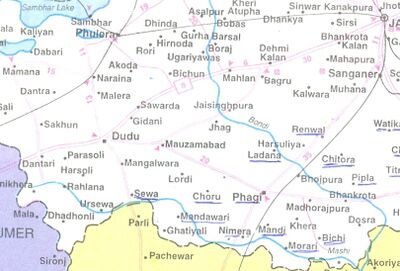Adarwa
| Author of this article is Laxman Burdak लक्ष्मण बुरड़क |
Adarwa (आदरवा) (Adarva) Village situated in the west of Dudu Tehsil of Jaipur District in Rajasthan. It is last village of Tehsil situated on the Ajmer District's Border.
Contents
Jat Gotras
History
Thakur Deshraj [1]has mentioned about Chhatris of Jewlia Jats in village Nirana (निराना) or Narena (नरेणा) near Kishangarh. Sita Ram Jewlia verified these Inscriptions and Chhatris of Jewlia Jats in village Adarwa and not in Naraina. Both these villages are adjacent. Naraina is in Phulera tahasil and Adarwa in Dudu tahsil of Jaipur district.
Adarwa Pillar Inscription of Jewlia Jat samvat 1111 (1054 AD)
An inscription in Devanagari script provides evidence of the rule of the Jewlia clan of Jats prior to the 10th century in Rajasthan. A Jewlia Jat chieftain had a chhatri constructed at Kishangarh. To the southwest of this chhatri is a victory pillar and a statue of a Jat chieftain of the Jewlia gotra, with an inscription of samvat 1111 (1054 AD). To the north of this chhatri, at a distance of 15 feet, there is an ancient masonry tank used to provide drinking water for cows, and a well, constructed from skilfully dressed and cut stones, demonstrating a high degree of talent in architecture. To the west of this chhatri is a huge pond spread over 50 bigha of land, also constructed by Jewlia Jat chieftains.
Gold coins
A gold coin was obtained in excavation near the above chhatri, engraved on one side with an image of the king with bow and arrow, and on the other side there with images of agni-kunda. The coin provides evidence for an ancestor of the present Jewlia clan being a king in the period prior to the 10th century.
जेवल्या की छतरी
ठाकुर देशराज लिखते हैं कि किशनगढ़ में उन्होंने तीन छतरियां देखी - दो राजपूतों की और एक जेवलिया गोत्र के जाट सरदार की. इसके पश्चिम में एक बड़ा भारी कीर्ति-स्तम्भ है. इस पत्थर में मनुष्य की मूर्ती खुदी हुई है और संवत 1111 का लेख खुदा हुआ है जो साफ-साफ पढ़ने में नहीं आ रहा है. लेख पुराना होने से घिस गया है. छतरी से दस हाथ उत्तर की और गौओं के लिए प्याऊ हेतु कुआ बनाया गया है. कुए की चिनाई इसकी प्राचीनता बता रही है. पत्थरों को काट कर पूठियाँ खड़ी हुई हैं. जैसे गाड़ी के पहिये की पूठियाँ होती हैं. इन पूठियों को जोड़कर कुआ बनाया गया है. कुए की मजबूती ऐसी कि हजारों साल तक रह सकता है. इसके पास गायों के पानी पिने के लिए खेल बनाई गई है. खेली की कारीगरी भी देखने लायक है. पांच-पांच हाथ लम्बी और तीन-तीन हाथ चौड़ी पत्थर की शिलाओं को जमीन में गाड़ कर खेली बनाई गयी है जिससे पत्थर की मरम्मत का सैंकड़ों वर्षों तक भी काम न पड़े. लोगों से सुना गया कि जिस जाट की कीर्ति को चिरकाल तक स्मरण रखने के लिए कुआ और छतरी बनाये थे उसी महापुरुष का बनाया हुआ छतरी के पश्चिम की और एक तलाब है जो गायों के पानी के लिए था. यह तालाब बड़ा भारी है, लगभग पचास बीघे में. यह स्तम्भ और निर्माण जाट की उस समय की शक्ति और समृद्धि को प्रकट करते हैं.[2]
ठाकुर देशराज ने 4 सिक्के भी देखे. तीन सिक्के चांदी के और एक ताम्बे का. एक सिक्का सोने का है. उपरोक्त कीर्ति स्तम्भ के पास एक गूजर जमीन खोद रहा था. उसकी जमीन में मिट्टी के दो ढ़कन के बीच ये सिक्के मिले. सोने की मोहर में एक और मनुष्य की मूर्ती है. उसके बाएं हाथ में धनुष है और दाहिने हाथ में तीर है. मोहर के दूसरी और अग्नि कुंड है जिसमें अग्नि की झलें निकल रही हैं और झलों के बीच एक मूर्ती दिख रही है. इससे यह अनुमान किया जा सकता है कि एक हजार वर्ष पहले जाटों का मुख्य धर्म अग्नि-पूजा करना था. यह भी अनुमान किया जा सकता है की 10 वीं सदी में यह जाट एक बड़ा राजा रहा होगा.[3]
Notable persons
References
- ↑ Jat Itihas by Thakur Deshraj (Hindi), Maharaja Suraj Mal Smarak Shiksha Sansthan, Delhi, 1934, 2nd edition (1992), pages 725-729.
- ↑ ठाकुर देशराज : जाट इतिहास, दिल्ली, 1992, पृ.725.
- ↑ ठाकुर देशराज : जाट इतिहास, दिल्ली, 1992, पृ.729.
Back to Jat Monuments/Jat Villages
